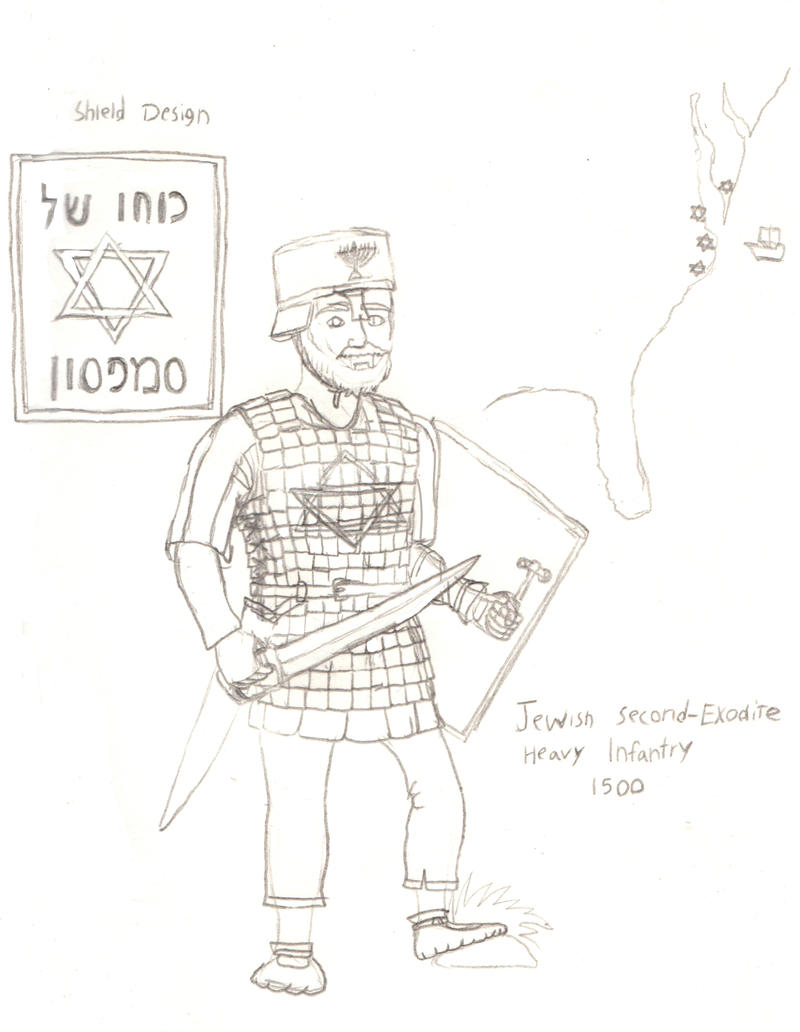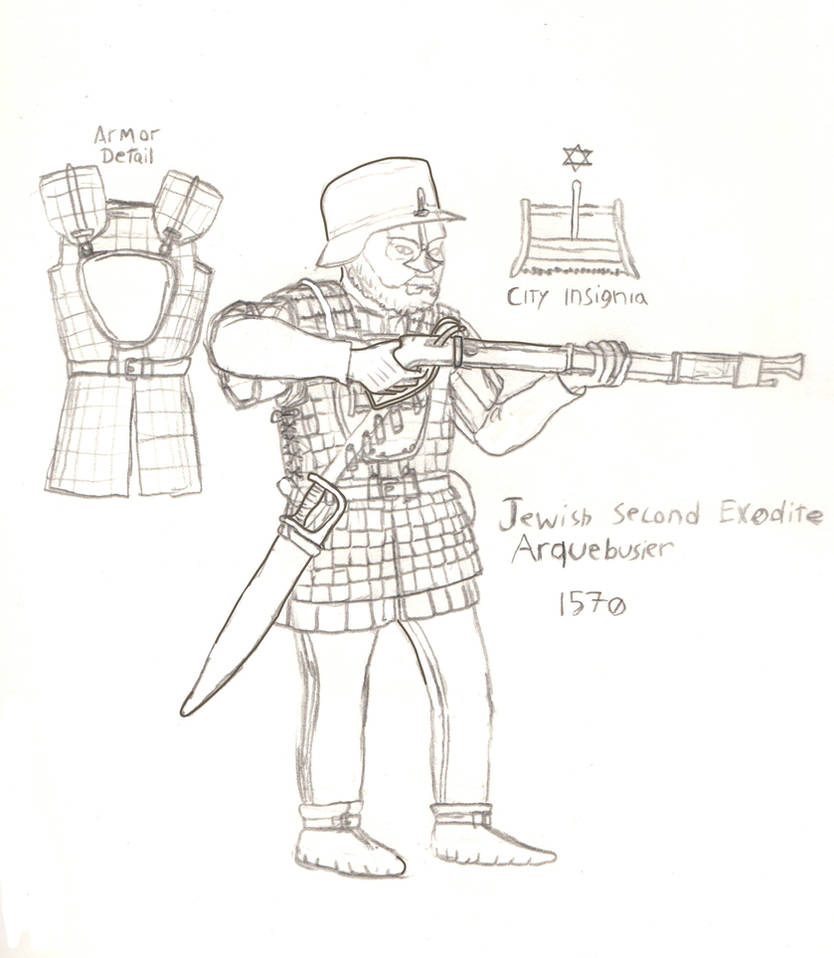
In 1290 in England there was a bookish young Jewish man named Mordecai, who due to the Act of Expulsion lost his family in an antisemetic attack. Left with nothing but a single three year old little sister, he was taken in by a family and in France turned himself into Torahic and Talmudic study to cope with his loss as well as deep contemplation. Combined with stories of other antisemetic attacks and rumours among fishermen, he eventually created a doctrine. In short, in Europe the Jews were not safe and what they needed was a way to escape to somewhere free of oppression by their Christian and Muslim overlords and those lands could be found across the sea. He soon had disciples which spread his message across France, Germany, Spain and the Low countries. Many found Mordecai's message to be madness and folly, but others were on board. A few thought of him as a Prophet, though he vehemently rejected this claim and Rabbis would confirm this posistion. Between 1298 and 1303, Jewish groups bought ships and some 26,000 Jewish men, woman and children set out falling the setting sun in this Second Exodus. On the crossing, 12,000 died from foundering, drowning, malnutrition and disease including Mordecai himself (though his sister would survive), leaving 14,000 to disembark in North America (specifically around Chesapeake Bay and Virginia). Of these, another 6,000 would die due to starvation, disease and attacks by hostile natives in the first years. Never the less, four enclaves were established in the New World.
Despite the initial hardships, these small settlements ultimately did fairly well. While nobody wanted to risk a return voyage, they did maintain contact with each other and provided aide. They worked the land and raised poultry, sheep and goats and plied the seas for fish. Cattle and Horses were also brought along, but with only a few animals (eleven surviving calves and six foals) to start it took decades before meaningful numbers were achieved. They fortified their towns with timber and then stone. Each enclave was run by a town council that voted on matters with particular prominence being given to master artisans, rabbis, ship's captains and proven warriors. For they would come into conflict with the established natives. It was not immediate nor universal, often the local tribes would trade with the Exodites and others allied with them while disease would thin out their numbers. Never the less, they would be embroiled in fights. Especially as having gone through the trauma of the Second Exodus they were determined to maintain their independence.
They came with some weapons and a bit of armour and their smiths could made more, often improvising whatever surplus tools they had. At first their goal was simply to arm as many people as possible and and laws were passed which mandated that each family keep weapons for when there was need of them. Eventually these were supplemented with a few Arms-Masters: proven warriors who were adept at fighting who'd lead the militia in battle and train them in exchange for better gear and food while performing their duties. As the population of the Exodites grew, the Arms-Masters would become more formalized as a semi-professional force, though despite some lobbying it would largely remain non hereditary. An attempted coup d'tat in 1387 in one enclave convinced the others of the folly of such courses of actions.
By 1500, the Exodite Enclaves had grown into seven City-States along the west coast with a population of 400,000 people (among them the descendants of conquered tribes and other natives, many of which have Judeified to various degrees, ranging to a few customs to full conversion and integration). Each of which retain a few hundred Arms-Masters, most of which are outfitted like this fellow. Armed with swords and and spears and clad in scale armor or maile over gambesons, they fight in phalanx formations. A few rich men and some leaders fight from horseback and they do have some capable archers, crossbowmen and slingers from the lower classes, but still the real strength of their armies lies in disciplined ranks of men. Fairly regularly, expeditions are organized to secure new lands and establish new homesteads.
To the South, the Spaniards have begun to establish colonies in Cuba and Hispaniola and soon other European powers will do the same. For the most part, they'll find Stone Age peoples with a few Bronze Age peoples in Meso-America and the Andes which they will subdue for their Kings, their God and Wealth and Glory, but on the Eastern Seaboard they'll find a people which steel weapons and armour (if less advanced than theirs) which both knows of these men from across the sea and are determined never to suffer their tyranny again.

The Jewish Second-Exodite City States first made contact in 1524 with the expedition of Giovanni da Verrazzano. Concerned first and foremost with exploration and completing his charts, this rediscovery went fairly smoothly and without bloodshed. This also confirmed the origin of some iron and steel items that Spaniards and other explorers would find among the natives in areas of North America. However, once word got to the Spaniards about the Jews of the New World several rumours circulated resulting in an attack by the would-be Conquistador Juan Corella and father Filipe Diaz. In 1532, they led four ships and some five hundred men against the Second Exodites expecting little resistance against a feeble foe. Instead after some minor victories in which they took a couple of farming and fishing villages and some minor massacres they were overcome by a formidable if somewhat primitive army of 8,000 soldiers mustered by a coalition of these city states against this threat. Despite inflicting some serious casualties, the conquistadors were killed, leaving only fifty men to retreat and as many captured. This victory happened in no small part due to narrative: the Second Exodus involved a desperate flight from Christian and Muslim persecution and the trials and travails endured in the passage and in building a new home in the new world were faced to never see. But while generations of Jews born and raised in the New World lived their lives hoping that their oppressors across the sea would never make the journey themselves, the possibility had been considered by Rabbi, Statesman and Soldier alike and when they did show up with swords, plate and fancy new alchemical weapons they were in agreement: grid your loins and drive them back into the sea.
A few more wars would be fought between the Second Exodites defending their homes (including territory that they had fairly recently expanded into) and the Spaniards to secure territory which they felt was rightfully theirs. Most of the fighting happened in the area of the OTL Carolinas. The Spaniards had an advantage at sea as well as forces which were generally more technologically advanced. The Second-Exodites had an local advantage in numbers, organization and fortifications. Most of the Spanish expeditions were informal affairs led by well connected hot-heads. Similarly the technological gulf between the two powers would gradually narrow. Through reverse engineering and items acquired by English, Danish and French merchants (as well as a trickle of Jews which sailed for the New World to join their lost brothers across the sea), the Second Exodites fairly quickly developed the capacity to make muskets of their own and used them to good effect against would-be conquistadors. Especially when backed up with pikes and halberds in formations that would mirror European counterparts.
---
Something I threw together.
Zor
Last edited: